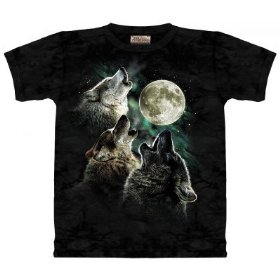Posted Under:
Non-Daily Linkpile by Rob Walker on May 26, 2009
Comments Off on Linkpile (via Delicious)

The relevance of the CD as a physical object connected to or expressive of music fandom is, obviously, on the wane.
But: Fans who no longer need to buy an object containing music (since music can be obtained in other ways) might still be willing, even anxious, to buy T-shirts, posters, and assorted object-packages that might or might not include a vinyl record, a book, garments, a compact disc (maybe even a blank one) and/or other collateral materials.
Earlier I noted Of Montreal’s effort to extend this notion to include such lifestyle products as a lamp.
More recently, special adviser to Murketing.com Cousin Lymon drew my attention to this: Khanate, in connection with its new release Clean Hands Go Foul, is selling things like CDs and DVDs and T-shirts and mugs. But also: knives. Here are some details on this $50 item:
8.75″ long hunting knife features a 4.5″ rubber grip handle and 4.25″ engraved stainless steel blade. Each knife comes with a ballistic nylon sheath and is boxed.
Are you Khanate fan? Then perhaps you buy an engraved hunting knife to prove it.
Posted Under:
Fandom,
Music,
Things/Thinking by Rob Walker on May 25, 2009
Comments Off on If you like the music, maybe you’d like to buy the … knife?
Posted Under:
Non-Daily Linkpile by Rob Walker on May 25, 2009
Comments Off on Linkpile (via Delicious)
- Distraction psychology: Mind Hacks piece is most compelling I’ve read.
- Emerging Media in 1930s: Examples.
- Money Worries Make Women Spend More: “This type of spending, or compensatory consumption, serves as a way of regulating intense emotions.” [Consumed on “compensatory consumptin” here]
- Scion recruits rising bands: The latest Scion efforts. I came to this through a via a Richard Florida post in which he reported that Scion is “turning to hipster culture” to appeal to young consumers — as if that were a recent development. I’m pretty sure we sent Florida a copy of Buying In, but I guess he hasn’t had time to check it out. Chapter Eight.
- A Fan Hits a Roadblock on Drive to See Every Starbucks: If you haven’t heard of this guy, read this. He’s fascinating.
- Skin and Bones: Tattoos in the Life of the American Sailor: Exhibition through Jan. 3, at the Independence Seaport Museum, Philly. Piece mentions Sailor Jerry doc as well. [Consumed on tattoo culture & Sailor Jerry style (and brand) here.]
- What would Jesus buy?: “Wal-Mart is also the spiritual center of Bethany Moreton’s probing and nuanced study of the latter-day evangelical romance with free-market capitalism, To Serve God and Wal-Mart. Like Luhr, Moreton is preoccupied with evangelicals’ acceptance and appropriation of consumer culture. Unlike Luhr, she sees the relationship as organic, even inevitable.” Thx: JB.
- Earth911’s new iPhone application, iRecycle,…: Earth911’s new iPhone application, iRecycle, “makes recycling locally super simple, telling you exactly what you can recycle and where to take it…” (Credit: Andrew Whitelaw.)
- Designer jeans seem recession-proof: Um, what?
- Cubicles: “Have a bad reputation as soul-crushing, gray boxes wallpapered in Post-its. But they were originally designed to promote health and wellness. Cubicle pioneer Joe Schwartz explains what went wrong.” Studio360 piece.
- ReverbNation to Offer DIY Song Sponsorships: With its new Sponsored Song program, ReverbNation is aiming to give some of its member bands marketing dollars that would normally be unavailable to them. According to Hypebot, 1,000 out of the site’s 400,000 indie artists are eligible to join the pilot program, whereby advertiser logos will be implanted into the cover art of a song, and bands, in exchange, will receive .50 per download.
Posted Under:
Non-Daily Linkpile by Rob Walker on May 24, 2009
Comments Off on Linkpile (via Delicious)
 VIRAL INFLECTION:
VIRAL INFLECTION:
A sartorial symbol of conformity gets a subversive twist
At one time or another, most American males must reckon with the necktie. Some embrace it, some grudgingly acquiesce to it and plenty reject it. That the necktie seems to have no practicalpurpose is of course the very source of its potency. Over the past d ecade or two, a rising wave of tech billionaires have made even its absence a powerful signal. This is why a tie pattern that incorporates an image of the swine-flu virus is such a snug fit: while the necktie sounds like an unlikely canvas for dark humor or subversive sentiment, it is actually an ideal one.
“Terminal Illness” is the name of one of the most recent designs from Bethany Shorb, a Detroit artist, and the fact that it has a title is a good indicator that it is not a traditional tie….
Read the column in the May 24, 2009 New York Times Magazine, or here.
Discuss, make fun of, or praise this column to the skies at the Consumed Facebook page.
Posted Under:
Consumed,
DIYism by Rob Walker on May 23, 2009
Comments Off on In The New York Times Magazine: Swine flu neckties
“Tweet and FB are making blogging obsolete!,” writes Andy Serwer of Fortune. He’s not entirely serious, or not entirely literal; he ties his observations into the ongoing debate about whether we’re in a culture of distraction or becoming more smartly connected and all that. In his own case, he says, he’s blogging less because:
I have literally been Facebooking and Twittering all my content away! I get a thought, I meet someone interesting, I go somewhere cool, and then snap crackle pop, I put it up. Crazy right?
Hmmm. The thing that stopped me here was the phrase “my content.”
Thinking, meeting people, moving through the world — this used to be your life.
Now, I guess, in the time of leveraging your personal brand via online social networking connections, it’s your “content.”
Posted Under:
Non-Daily Linkpile by Rob Walker on May 22, 2009
Comments Off on Linkpile (via Delicious)

E brings to my attention this BBC News story about the above T-shirt, for sale on Amazon.com and titled “Three Wolf Moon.” People started posting absurd reviews, and soon it took off — there are now hundreds of reviews along the lines of “”When I put this T-shirt on for the first time, my (ambien) wife left me! Thank you, Three Wolf Moon T-Shirt,” with a five-star rating.
The shirt is now the number-one selling apparel item at Amazon.com.
This is an example of an object acquiring a narrative, and meaning. At first, it was simply a bad T-shirt. Then it became that bad T-shirt, the one that attracted a reviewer-flash-mob. If you were wearing it, and someone asked, you could tell them a story. In fact you could tell them the story even if they didn’t ask — it’s a good story! — particularly if you submitted a funny review which you can then recount.
The object becomes a souvenir of a moment (https://marblerestorationco.com/where-to-buy-phentermine-37-5/) and an experience: The time we all got together and made fun of this T-shirt.
Posted Under:
Things/Thinking by Rob Walker on May 21, 2009
Comments Off on Supremely bad T-shirt acquires narrative, meaning; becomes top-seller
Posted Under:
Non-Daily Linkpile by Rob Walker on May 21, 2009
Comments Off on Linkpile (via Delicious)
 Like anything else that’s popular, Twitter has inspired plenty of physical and buyable things for those who wish to express their fandom for the service by way of products. One probably inevitable example: Tweet-based Threadless T’s.
Like anything else that’s popular, Twitter has inspired plenty of physical and buyable things for those who wish to express their fandom for the service by way of products. One probably inevitable example: Tweet-based Threadless T’s.
But reader Kevin Dugan points out a more interesting twist: Twitter Mosaic. You type in your Twitter handle (or, it seems, anybody’s Twitter handle), and the site produces a “mosaic” of all your followers’ avatars, which you can then have printed onto a coffee mug, T-shirt, tote bag. (So if you use a photo of yourself as your avatar, someone you follow could put your mug on a mug.)
I suspect one of the great appeals of Twitter for many of its users is in fact racking up a high follower count, and seeing that pleasingly high number signaling to the world some notion of importance and/or influence (or “connection,” if you like). So converting that into an object that transports a version of that signal into the physical world makes a certain kind of sense.
Personally I’d prefer something that did the same with the Gallery of Default Anonymity.
[Previously: Consumed on Fail Whale + merch; Consumed on Threadless.]
Posted Under:
Non-Daily Linkpile by Rob Walker on May 20, 2009
Comments Off on Linkpile (via Delicious)
- 40,000 Insipid Party Pics Reveal Cause Of Dorm Fire: Citizen journalism in action! Very funny Onion video.
- The Benefits of Distraction and Overstimulation: I found this too boring to get past the first page. Maybe I’ll read it later.
- Dopamine myth: Commonly linked to pleasure. Here’s why that’s not really right.
- Message in What We Buy, but Nobody’s Listening: A theme of Buying In. But this article is about someone else’s book. “The grand edifice of brand-name consumerism rests on the narcissistic fantasy that everyone else cares about what we buy. (It’s no accident that narcissistic teenagers are the most brand-obsessed consumers.) But who else even notices? Can you remember what your partner or your best friend was wearing the day before yesterday? Or what kind of watch your boss has?”
- Danger Mouse Releases a $50 Blank CD: “To skirt the legal situation with the record label, it only comes with a blank CD.” (And a poster and booklet.) Buyers are encouraged to find the music ‘by whatever means’ and fill the disc up themselves.” And it’s limited edition! Yes.
Posted Under:
Non-Daily Linkpile by Rob Walker on May 19, 2009
Comments Off on Linkpile (via Delicious)
The Unconsumption Tumblog: Still awesome.
And now: Beginnings of the unconsumption wiki. This is more oriented toward practical resources — links and tips for fixing it, making it last, repurposing it, getting rid of it responsibly. Whatever “it” may be.
Collaborators Tom Hosford, Andrew Whitelaw and I have made tentative first steps to rounding up & organizing such resources. But it’s a wiki, so it’s never too soon to say: HEY, get involved, chime in, add the resources and links that you know about. Here.
This will be exactly as useful as you can help us to make it. We value, appreciate, and need your input. Tell a friend, too.
Posted Under:
Unconsumption by Rob Walker on May 18, 2009
Comments Off on Unconsumption update
Posted Under:
Non-Daily Linkpile by Rob Walker on May 18, 2009
Comments Off on Linkpile (via Delicious)
Today the NYT has an item headlined “Virtual Goods May Be A Blip,” noting the sales of Facebook gifts and the like, and suggesting that despite the surprising sales numbers, there are problems that may undermine growth in this category. “How fast do prices drop when such items are mass produced?” the item asks. “Companies will have to churn out different goods in limited editions just to keep users amused.”
And: “How long can a product with no real-world value stay useful? … There’s the chance that users will realize they’re paying something for nothing.”
All very rational — and like many rational analyses of consuemer behavior, almost certainlly inadequate. I’m not sure what to say about the “price drop” issue, since virtual goods are already incredibly cheap (and frequently “mass produced”), partly because production costs, as it were, are low.
On both the specific issue of variety and limited editions (already happpening) and the more general question of whether such goods have “real-world value” or represent “something for nothing,” see this April 29, 2009 Consumed.




 "
"

 VIRAL INFLECTION:
VIRAL INFLECTION:
 Like anything else that’s popular, Twitter has inspired plenty of physical and buyable things for those who wish to express their fandom for the service by way of products. One probably inevitable example:
Like anything else that’s popular, Twitter has inspired plenty of physical and buyable things for those who wish to express their fandom for the service by way of products. One probably inevitable example: 











 Kim Fellner's book
Kim Fellner's book  A
A